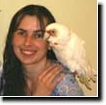To Feed Grit Or Not To Feed Grit
Kristen Reeves, Meadowlark Farms Avian Supply, Inc.
There are birds who eat seed whole - hull and all - such as doves, pigeons, chickens, larger poultry, etc. Then there are birds that hull their seeds, like canaries, finches, waxbills and most hookbills.
Birds that DO NOT hull their seedneed grit and eat insoluble stuff - sand, small pebbles or rocks, etc. This form of grit helps the keratin plates in their gizzard grind the seed they've consumed.
It has been said that birds that DO hull their seed do not have gizzards and don't require grit. Where that notion came from is beyond me. Every bird has a gizzard and some even have “expanded” gizzards. In fact, not only do they all have gizzards, but ALL seed eating birds consume grit in one form or another regardless of whether they hull their seeds or not. The only time they would not consume grit is if they are captive and it is not being offered. They don't have teeth and therefore cannot chew the seeds. They eat grit to help them grind those whole seeds.
SIDE NOTE: I’ve performed necropsies on hundreds of birds over the years. Within the gizzard of every single one of those birds were tiny bits of grit ranging in size from a grain of sand to larger chunks of broken cuttlebone outer shell and even gravel. I actually use it as a diagnostic tool. Often when nutrition is lacking, birds will eat large amounts of grit to “fill the void”. In most cases, there is a bacterial or parasitic infection affecting how their body absorbs nutrients. When they can’t get enough food, they will often eat large amounts of grit. Small amounts of grit in the droppings is normal and to be expected, but when I see large amounts, I know there is another issue and take action to determine exactly what is going on.
The above photo shows the gizzard of a Gouldian finch upon necropsy. Within the gizzard are hulled seeds (millet) and dark pieces of grit and charcoal
Have you ever seen wild birds pecking at the dirt or bathing in the dust?
While down there, those birds are consuming minute particles of sand, dirt and very small pebbles - GRIT. They NEED it. They know what they need and instinctively eat those items. Wild birds don't have a human feeding them calcium, grit or mineral supplements. Where do you suppose they get those items in the wild??? From the dirt!
Soluble grit (trace mineral dust, flaked oyster shell, crushed egg shell, crushed cuttlebone [the hard outer portion], etc.) offers the bird a bit of grinding aid while providing them with minerals they need. Insoluble grit and larger pieces offer more grinding when necessary.
Pet store grit made for canaries is usually slightly larger than what I feed to the smaller finches & waxbills, and I actually offer my canaries a finer grit than what is sold in pet stores (see MLFAS Gould-Granules).
They don't eat the larger pieces as often because the smaller stuff usually does the trick. But the gizzard may need help from time to time and the birds will consume what they need. Because of this, my Gould-Granules contains fine river sand (insoluble) mixed with the above mentioned soluble forms. They pick at it when they need it, and leave it alone when they don't.
It’s up to you whether you feed grit or not. But the fact is, every bird has a gizzard and NEEDS grit in some form.





